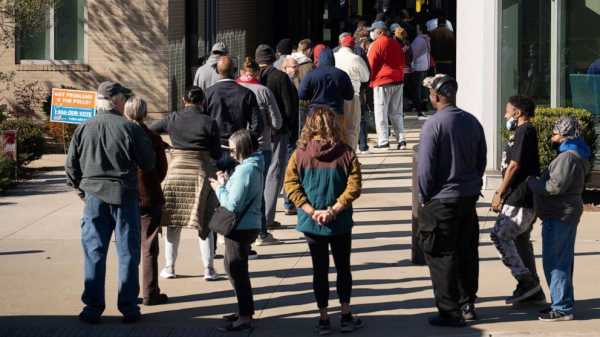Georgians swarmed to the polls on the last day of early voting before next week’s Senate runoff, setting a new record for single-day early in-person turnout.
At least 352,953 people voted in person on Friday, bringing the total number of votes, either in person or absentee, to over 1.8 million. That number represents 26.4% of active voters.
It’s a strong start for turnout for the Dec. 6 contest between Democratic incumbent Sen. Raphael Warnock and his Republican challenger Herschel Walker.
Neither candidate clinched the 50% needed to win the general election in November, though Warnock led Walker 49% to 48%.
MORE: Obama stumps for Warnock with five days left to go in Georgia runoff
It’s the second runoff Warnock is facing after he defeated former Sen. Kelly Loeffler in January 2021 in a special election. Warnock’s win, along with that of Democrat Jon Ossoff, handed Democrats majority control of the Senate.

Raphael Warnock, Democratic Senator from Georgia, speaks to supporters at a U.S. midterm election night party in Atlanta, Nov. 9, 2022. Republican candidate for U.S. Senate Herschel Walker rallies with supporters at a campaign stop in Newnan, Ga., Nov. 4, 2022.Reuters
Democrats kept their narrow control of the Senate this midterm cycle, capturing the 50 seats necessary when Sen. Catherine Cortez Masto of Nevada won her reelection bid.
But Republicans are hoping to keep the chamber at its current 50-50 split, while a 51-seat majority would make governing for Democrats a bit easier.
“We have to win this election,” President Joe Biden said Friday at a Democratic fundraiser for Warnock in Boston. “It will give us 51 votes. And that changes the dynamic of anybody being able to say they want to change what we’re going to do.”
MORE: What difference would a 51-seat Senate Democratic majority make?
The runoff between Warnock and Walker’s broken early voting records several times since polls opened statewide on Nov. 28.
On Tuesday, the previous record, over 304,700 Georgians voted. Monday also set a record for one day when over 303,000 Georgians went to the polls on the first day of statewide early in-person voting. Before the runoff, the previous single-day turnout record was 233,252, set on the last day of early voting in 2018.

Voters line up at Metropolitan Library to cast their ballots in the runoff election for the Senate position, between Democratic incumbent Raphael Warnock and Republican candidate Herschel Walker, in Atlanta, on Nov. 29, 2022.Megan Varner/Reuters
With just 3 days left until Election Day, Warnock is holding a slate of events on Saturday.
Warnock held a “Super Labor Saturday Rally and Canvass” with Georgia AFL-CIO, and later will hold a GOTV rally in Augusta before rallying with Ossoff and members of the AAPI community including: Emmy-winning TV host Jeannie Mai Jenkins, author Min Jin Lee, actor Daniel Dae Kim, and singer Ari Afsar.
Walker, on the other hand, did not advise the press on any public campaign events for Saturday. However, ABC News has learned Walker will be tailgating at the Mercedes-Benz Stadium ahead of the SEC Championship football game.
Sourse: abcnews.go.com